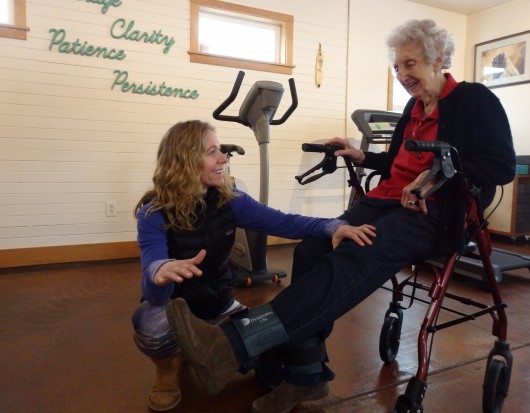As senior populations grow throughout Southeast Alaska, what kind of impact do they have on the economy? According to experts, it’s a good one. A state report on Alaska’s aging population says seniors contributed an estimated $2.4 billion to the economy in 2014. That comes mostly from retirement income, health care spending and wages.
As part of CoastAlaska’s Aging Southeast series, KHNS’s Emily Files tells us more from Haines.

Physical therapist Marnie Hartman works with 92-year-old patient Marge Ward. Hartman says most of her business comes from people 65 and older. (Photo by Emily Files/KHNS)
Ron Jackson is 75 years old. He moved to Haines 15 years ago, after retirement.
“This was the closest thing to home that I’d ever felt. So that was pretty cool. It was like, I belong here. And I’ve been here longer than I have any place in my life.”
As Jackson puts it, in Haines, there’s “gray hair everywhere.” Eighteen percent of residents are 65 or older. And seniors are on track to make up more than a third of the population by 2024.
Haines also has the oldest median age in the state – 48.5. That’s about 14 years above the state average and nine years above the region.
How does the abundance of seniors in this 2,000-person town impact its economy? Here’s state economist Conor Bell:
“One thing is that retirement income works as an injection into the economy, where it’s basically outside dollars that retirees are able to use on goods and services purchased locally. So it’s money that wouldn’t otherwise be circulating the economy.”
“It does seem that we have a thriving senior community. A lot of our business is from the seniors.” (Hear and read other reports in our Aging Southeast series.)
Christy Tengs owns the Bamboo Room Restaurant. The majority of customers she saw on a recent Monday morning were seniors.
Jackson says older customers are especially important in communities like Haines, where the economy booms in the summer and busts in the winter.
“Throughout that entire year, a senior income is stable, generally it’s some annuity that’s been earned or social security and it survives the ups and downs of an economy.”
Economist Bell says another benefit that comes from a large senior population is increased demand for healthcare.
Marnie Hartman, a doctor of physical therapy in Haines, says that’s been her experience.
“I would say probably 50 to 60 percent of my patient base, depending on the flow at that time, qualifies for Medicare, which is 65 and older.”
After nine years at the local clinic, she opened her own practice. She wasn’t sure if she would have enough patients. But she’s been almost too busy to handle the load.
Those 65 and older have a positive economic impact by bringing in stable, outside incomes and more healthcare spending. But what about the tax breaks they receive?
Take for example, the state-mandated senior property tax exemption. It tells municipalities not to charge property tax on the first $150,000 value of a home.
“So if you had a $200,000 house, you were only paying on $50,000.”
Kathie Wasserman is the executive director of the Alaska Municipal League. AML is fighting the tax-exemption mandate. She says the state should reimburse local governments for the money lost on the exemption.
“We have always said that municipalities need the freedom to look at this policy within their own community and say, ‘OK, this is our financial position at this time and we can afford this or we can’t afford to exempt everybody.’”
State data shows that in Fiscal Year 2015, the exemption cost Southeast communities more than $5 million.
In addition to that lost revenue, some municipalities have senior sales tax exemptions. Sitka, Petersburg and Juneau leaders are among those who have considered doing away with the breaks. With a rapidly aging population, some say they’re unsustainable. But all of those efforts were met with community backlash.
“I think I paid my dues, I really, truly do. I’m 80 years old and I’m still working. And, I don’t know, it’s just disgusting that you keep picking on the old people.”
That’s Sitka resident Shirley Robards speaking to the borough assembly in 2015. The only one of those three Southeast towns that successfully scaled back senior tax breaks is Juneau.
Economist Bell says things like tax exemptions lead some people to view an aging population as inherently bad for an economy. But he disagrees.
“It’s underrated the amount of impact retirees and an aging population can bring to a community.”
Jackson, the 75-year-old retiree, says Haines seniors are involved.
“The definition of a senior isn’t an old person who sits around a lot and drains the system. They’re out there hiking the trails and working on projects.”
He says aside from spending at local businesses, seniors volunteer and serve in government. And he’s not alone in that view. Many in Haines say the same thing – seniors here are active, they contribute to the community.
Read and hear other reports in our Aging Southeast series through links posted on our website. Stay tuned for more CoastAlaska reports on seniors in the region.






